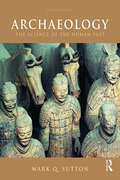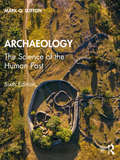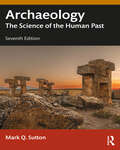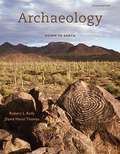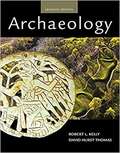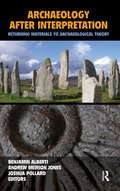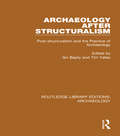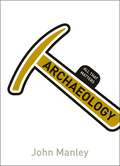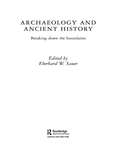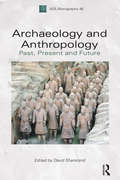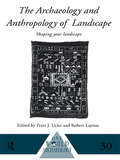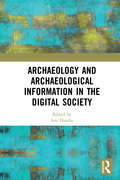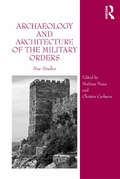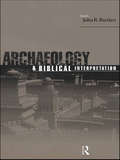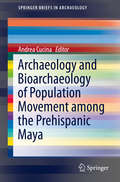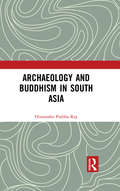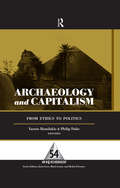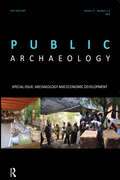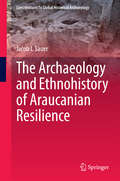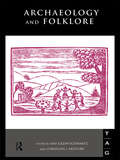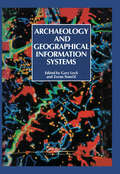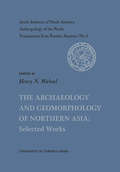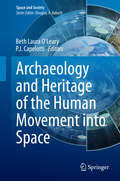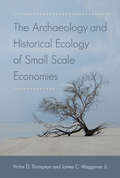- Table View
- List View
Archaeology: The Science of the Human Past
by Mark Q SuttonArchaeology: The Science of the Human Past provides an introduction to the broad and fascinating world of archaeology from the scientific perspective. Conveying the exhilaration of archaeological work, it explores the ways archaeologists analyse and interpret evidence. Varying perspectives are considered to provide holistic coverage of archaeological techniques and methods and show how the complexity of the past can be captured by the empirical science of archaeology. The Fifth Edition has been updated and revised to include the latest archaeological approaches and the impact developments in archaeological science have made in recent years. The chapter on bioarchaeology has been completely rewritten to reflect these developments. Archaeology: An Introduction will allow students to understand the theoretical and scientific aspects of archaeology and how various archaeological perspectives and techniques help us understand how and what we know about the past.
Archaeology: The Science of the Human Past
by Mark Q. SuttonArchaeology: The Science of the Human Past provides students with a thorough understanding of what archaeology is and how it operates and familiarizes them with fundamental archaeological concepts and methods. This volume introduces the basic components of archaeology, including sites, artifacts, ecofacts, remote sensing, and excavation. It discusses how archaeologists obtain and classify information and how they analyze this information to formulate and test models of what happened in the past. Cultural resource management and the laws and regulations that deal with archaeology around the world are described. Archaeology is placed in the context of contemporary issues, from environmental problems to issues affecting Indigenous populations. The sixth edition has been updated and simplified to create a more streamlined volume to meet the needs of the students and teachers for whom it is designed, reflecting the latest developments in archaeological techniques and approaches. Allowing students to understand the theoretical and scientific aspects of archaeology and how various archaeological perspectives and techniques help us understand how and what we know about the past, Archaeology: The Science of the Human Past is an ideal introduction to archaeology.
Archaeology: The Science of the Human Past
by Mark Q. SuttonArchaeology: The Science of the Human Past introduces students to the wide-ranging and fascinating world of archaeology and provides them with a comprehensive understanding of fundamental archaeological concepts and methods.The seventh edition keeps pace with the developments in archaeological science with up-to-date information on dating, artifact analyses, and remote sensing. Theoretical developments in power, gender, and cognition are also included. Introducing the key components of archaeology, including sites, artifacts, ecofacts, remote sensing, and excavation, it discusses the ways archaeologists obtain, analyze, and interpret evidence. Varying perspectives are considered to provide holistic coverage of how archaeological techniques and methods are used to formulate and test models of what happened in the past. Cultural resource management and the laws and regulations that deal with archaeology around the world are described. Archaeology is placed in the context of current topics, from environmental problems to issues affecting Indigenous populations.Archaeology: The Science of the Human Past remains an ideal introduction to archaeology by offering students a broad and clear understanding of the theoretical and scientific aspects of archaeology and how various archaeological perspectives and techniques help us comprehend not just the past but the contemporary world as well.
Archaeology: Down to Earth (4th edition)
by David Hurst Thomas Robert L. KellyThis new brief edition pairs two of archaeology's most recognized names--David Hurst Thomas of the American Museum of Natural History and Robert L. Kelly of the University of Wyoming. The authors' passionate, down-to-earth introduction to archaeological method and theory makes the book ideal for all students, whether or not they intend to pursue a career in archaeology. Students will gain an immediate, concrete impression of what the practice of archaeology involves. The authors include well-chosen examples to show how archaeologists have worked through actual problems in the field and in the lab. After using this text, students will be better able to ask questions, solve problems, and discern "truth" from "fiction. " They will learn about the nature of archaeological data and how archaeologists do such things as archaeological survey and excavation. They will also develop their sense of scientific logic and gain a better understanding of career opportunities available to archaeologists. This edition is enhanced with a new full-color design that improves the visual presentation and enables students to more clearly see the key points of an image. A rich array of supplemental resources includes a new companion website as well as the option to use the DOING FIELDWORK: ARCHAEOLOGICAL DEMONSTRATIONS CD-ROM, Version 2. 0, also developed by the authors.
Archaeology
by David Thomas Robert KellyThe seventh edition of ARCHAEOLOGY reflects the most recent research and changes in the field, while making core concepts easy to understand through an engaging writing style, personalized examples, and high-interest topics. This text pairs two of archaeology's most recognized names, Robert L. Kelly and David Hurst Thomas, who together have over 75 years of experience leading excavations.
Archaeology After Interpretation: Returning Materials to Archaeological Theory
by Benjamin Alberti Andrew Meirion Jones Joshua PollardA new generation of archaeologists has thrown down a challenge to post-processual theory, arguing that characterizing material symbols as arbitrary overlooks the material character and significance of artifacts. This volume showcases the significant departure from previous symbolic approaches that is underway in the discipline. It brings together key scholars advancing a variety of cutting edge approaches, each emphasizing an understanding of artifacts and materials not in terms of symbols but relationally, as a set of associations that compose people’s understanding of the world. Authors draw on a diversity of intellectual sources and case studies, paving a dynamic road ahead for archaeology as a discipline and theoretical approaches to material culture.
Archaeology After Structuralism: Post-structuralism and the Practice of Archaeology (Routledge Library Editions: Archaeology)
by Ian Bapty Tim YatesMost practising archaeologists have preferred to leave the deep theories of what lies behind their methods and perceptions on one side. Now archaeologists have faced up to the difficult task of making (or not making) the connections between the past, interpretation and the present. The writers of this volumes address the problems of archaeology, sometimes warily and sometimes with enthusiasm. The connections are not easy to accomplish: a great deal of theory seems of little relevance to the everyday practice of archaeology, and much of post-structuralism refers exclusively back to itself rather than to the more specific concerns of a historical discipline. But where the junction between post-structuralism and archaeology can be made, the results are innovative and enriching. Originally published in 1990.
Archaeology: All That Matters (All That Matters)
by John Manley- When did archaeology begin?- Who were the first antiquarians in early modern Europe?- How did archaeology free human history from biblical creationism?- How did archaeology become a pseudo-scientific discipline?- Who built the first museum? Leading expert Dr John Manley starts by dealing with the processes and techniques used by archaeologists, in the past and today. He then uses the results of famous archaeological studies both to illustrate the power of archaeology, and to show specifically what archaeology has taught us about Roman, Egyptian, ancient, and surprisingly recent, history. In an exciting final chapter, Manley wonders how archaeology may adapt over time, exploring how the archaeologists of the future may examine our own era.Ideal for students or for general reading, this book delivers a thorough and comprehensive introduction to archaeology. All That Matters about archaeology. All That Matters books are a fast way to get right to the heart of key issues.
Archaeology and Ancient History: Breaking Down the Boundaries
by Eberhard W. SauerChallenging both traditional and fashionable theories, this collection of pieces from an international range of contributors explores the separation of the human past into history, archaeology and their related sub-disciplines. Each case study challenges the validity of this separation and asks how we can move to a more holistic approach in the study of the relationship between history and archaeology. While the focus is on the ancient world, particularly Greece and Rome, rhe lessons learnded in this book make it an essential addition to all studies of history and archaeology.
Archaeology and Anthropology: Past, Present and Future (Association Of Social Anthropologists Monographs #48)
by David ShanklandThough archaeologists have long acknowledged the work of social anthropologists, anthropologists have been much less eager to repay the compliment. This volume argues that the time has come to recognise the insights archaeological approaches can bring to anthropology. Archaeology's rigorous approach to evidence and material culture; its ability to develop flexible research methodologies; its readiness to work with large-scale models of comparative social change, and to embrace the latest technology all means that it can offer valuable methods that can enrich and enhance current anthropological thinking.Cross-disciplinary and international in scope, this exciting volume draws together cutting-edge essays on the relationship between the two disciplines, arguing for greater collaboration and pointing to new concepts and approaches for anthropology. With contributions from leading scholars, this book will be essential reading for students and scholars of archaeology, anthropology and related disciplines.
The Archaeology and Anthropology of Landscape: Shaping Your Landscape (One World Archaeology #Vol. 30)
by Peter J. Ucko Robert LaytonThe Archaeology and Anthropology of Landscape contributes to the development of theory in archaeology and anthropology, provides new and varied case studies of landscape and environment from five continents, and raises important policy issues concerning development and the management of heritage.
Archaeology and Archaeological Information in the Digital Society
by Isto HuvilaArchaeology and Archaeological Information in the Digital Society shows how the digitization of archaeological information, tools and workflows, and their interplay with both old and new non-digital practices throughout the archaeological information process, affect the outcomes of archaeological work, and in the end, our general understanding of the human past. Whereas most of the literature related to archaeological information work has been based on practical and theoretical considerations within specific areas of archaeology, this innovative volume combines and integrates intra- and extra-disciplinary perspectives to archaeological work, looking at archaeology from both the inside and outside. With fields studies from museums and society, and pioneering new academic research, Archaeology and Archaeological Information in the Digital Society will interest archaeologists across the board.
Archaeology and Architecture of the Military Orders: New Studies
by Mathias Piana Christer CarlssonAs elite communities in medieval societies the Military Orders were driven by the ambition to develop built environments that fulfilled monastic needs as well as military requirements and, in addition, residential and representational purposes. Growing affluence and an international orientation provided a wide range of development potential. That this potential was in fact exploited may be exemplified by the advanced fortifications erected by Templars and Hospitallers in the Levant. Although the history of the Military Orders has been the subject of research for a long time, their material legacy has attracted less attention. In recent years, however, a vast range of topics concerning the Orders’ building activities has become the object of investigation, primarily with the help of archaeology. They comprise the choice of sites and building materials, provision and storage of food and water, aspects of the daily life, the design and layout of commanderies, churches and fortifications, their spatial arrangement, and the role these buildings played in their environmental context. This volume contains ten articles discussing the archaeology and architecture of buildings erected by the three major Military Orders in different geographical regions. They cover most countries of Western Europe and include a number of important fortifications in the Levant. These studies break new ground in the investigation of the built fabric of the Military Orders. Written by noted international scholars this publication is an important contribution to modern research on these institutions, which, in their association of monasticism and knighthood, were so typical for the Middle Ages.
Archaeology and Biblical Interpretation
by John R. BartlettThe contributors in this book use the most recent research in key areas - the early settlements of Israel, early Israelite religion, Qumran, Jerusalem, early Christian churches - to show that ancient writings and modern archaeology can illuminate each other, but only when used with professional care. The essays represent a new generation of archaeologists and historians, with new social, political and religious concerns who draw a fresh and vital picture of the emergence of ancient Israel.
Archaeology and Bioarchaeology of Population Movement among the Prehispanic Maya (SpringerBriefs in Archaeology #4)
by Andrea CucinaArchaeological evidence - i. e. presence of exogenous, foreign material objects (pottery, obsidian and so on) - is used to make inferences on ancient trade, while population movement can only be assessed when the biological component of an ancient community is analyzed (i. e. the human skeletal remains). But the exchange of goods or the presence of foreign architectural patterns does not necessarily imply genetic admixture between groups, while at the same time humans can migrate for reasons that may not be related only to trading. The Prehispanic Maya were a complex, highly stratified society. During the Classic period, city-states governed over large regions, establishing complex ties of alliance and commerce with the region's minor centers and their allies, against other city-states within and outside the Maya realm. The fall of the political system during the Classic period (the Maya collapse) led to hypothetical invasions of leading groups from the Gulf of Mexico into the northern Maya lowland at the onset of the Postclassic. However, it is still unclear whether this collapse was already underway when this movement of people started. The whole picture of population dynamics in Maya Prehispanic times, during the Classic and the Postclassic, can slowly emerge only when all the pieces of the puzzle are put together in a holistic and multidisciplinary fashion. The contributions of this volume bring together contributions from archaeology, archaeometry, paleodemography and bioarchaeology. They provide an initial account of the dynamic qualities behind large-scale ancient population dynamics, and at the same time represent novel multidisciplinary points of departure towards an integrated reconstruction and understanding of Prehispanic population dynamics in the Maya region.
Archaeology and Buddhism in South Asia: An Archaeology Of Museum Collections (Archaeology And Religion In South Asia Ser.)
by Himanshu Prabha RayThis book traces the archaeological trajectory of the expansion of Buddhism and its regional variations in South Asia. Focusing on the multireligious context of the subcontinent in the first millennium BCE, the volume breaks from conventional studies that pose Buddhism as a counter to the Vedic tradition to understanding the religion more integrally in terms of dhamma (teachings of the Buddha), dāna (practice of cultivating generosity) and the engagement with the written word. The work underlines that relic and image worship were important features in the spread of Buddhism in the region and were instrumental in bringing the monastics and the laity together. Further, the author examines the significance of the histories of monastic complexes (viharas, stupas, caityas) and also religious travel and pilgrimage that provided connections across the subcontinent and the seas. An interdisciplinary study, this book will be of great interest to students and scholars in South Asian studies, religion, especially Buddhist studies, history and archaeology.
Archaeology and Capitalism: From Ethics to Politics (One World Archaeology Ser. #54)
by Yannis Hamilakis Philip DukeThe editors and contributors to this volume focus on the inherent political nature of archaeology and its impact on the practice of the discipline. Pointing to the discipline’s history of advancing imperialist, colonialist, and racist objectives, they insist that archaeology must rethink its muted professional stance and become more overtly active agents of change. The discipline is not about an abstract “archaeological record” but about living individuals and communities, whose lives and heritage suffer from the abuse of power relationships with states and their agents. Only by recognizing this power disparity, and adopting a political ethic for the discipline, can archaeology justify its activities. Chapters range from a critique of traditional ethical codes, to examinations of the capitalist motivations and structures within the discipline, to calls for an engaged, emancipatory archaeology that improves the lives of the people with whom archaeologists work. A direct challenge to the discipline, this volume will provoke discussion, disagreement, and inspiration for many in the field.
Archaeology and Economic Development
by Paul Burtenshaw"Nowhere in archaeology is the gap between theory and practice more evident than in its ambivalent engagement with economic development. This groundbreaking volume assembles practicing archaeologists, economists, and NGO officials in an extensive exploration of the theoretical, practical and ethical issues raised by archaeologists' use of cultural heritage to support economic development. The first chapters consider the problem of articulating the value of tangible and intangible heritage when economic measures alone are inadequate. Subsequent chapters present regional perspectives on archaeology and development, and present a host of case studies from around the globe that describe archaeologists' development projects, including some that are successful and others that are less so. These studies both suggest best practices in the implementation of development projects and illuminate the obstacles to success created by political conflict and competing human needs. Ethical issues and practical considerations converge in chapters that explore the role that members of local communities should play in the design, management and governance of archaeological and heritage resources. In this volume, archaeologists and heritage professionals will encounter a thought-provoking international discourse concerning the path forward for archaeology as the field engages with economic development."
The Archaeology and Ethnography of Central Africa
by James DenbowThe Archaeology and Ethnography of Central Africa provides the first detailed description of the prehistory of the Loango coast of west-central Africa over the course of more than 3,000 years. The archaeological data presented in this volume comes from a pivotal area through which, as linguistic and historical reconstructions have long indicated, Bantu-speaking peoples expanded before reaching eastern and southern Africa. Despite its historical importance, the prehistory of the Atlantic coastal regions of west-central Africa has until now remained almost unknown. James Denbow offers an imaginative approach to this subject, integrating the scientific side of fieldwork with the interplay of history, ethnography, politics, economics, and personalities. The resulting anthropology of archaeology highlights the connections between past and present, change and modernity, in one of the most inaccessible and poorly known regions of west-central and southern Africa.
The Archaeology and Ethnohistory of Araucanian Resilience
by Jacob J. SauerThis volume examines the processes and patterns of Araucanian cultural development and resistance to foreign influences and control through the combined study of historical and ethnographic records complemented by archaeological investigation in south-central Chile. This examination is done through the lens of Resilience Theory, which has the potential to offer an interpretive framework for analyzing Araucanian culture through time and space. Resilience Theory describes "the capacity of a system to absorb disturbances and reorganize while undergoing change so as to still retain the same function. " The Araucanians incorporated certain Spanish material culture into their own, rejected others, and strategically restructured aspects of their political, economic, social, and ideological institutions in order to remain independent for over 350 years.
Archaeology and Folklore (Theoretical Archaeology Group Ser.)
by Amy Gazin-Schwartz Cornelius HoltorfArchaeology and Folklore explores the complex relationship between the two disciplines to demonstrate what they might learn from each other.This collection includes theoretical discussions and case studies drawn from Western Europe, the Mediterranean and North. They explore the differences between popular traditions relating to historic sites and archaeological interpretations of their history and meaning.
Archaeology And Geographic Information Systems: A European Perspective
by Gary Lock Zoran StančičGeographic information systems GIS applications are viewed with increasing interest by the archaeology community and this book, with its diversity of topics and authorship, should be a useful resource. Complementing the volume "Interpreting Space" Taylor & Francis, 1990, which focused on North American archaeology, this title further develops themes within a specifically - though not exclusively - European context.; It is apparent that there are fundamental differences between North American and European archaeological uses of GIS. Primarily these differences lie in the types of evidence for past landscapes that are available for study in the two continents, and secondly in the different approaches to archaeology and specifically the theory and practice of landscape archaeology. This title centres on the role of archaeological theory in cultural resource management CRM and in GIS applications generally. It showcases the important debate which takes the emphasis away from the technology of GIS and places it back within the central concerns of archaeology and particularly European archaeology.; "Archaeology and GIS" includes material on such concerns as CRM applications, landscape archaeology, intra-site applications and explicitly theoretical concerns, thus representing the state of GIS applications in European archaeology. Contributions come from countries such as France, Italy, Hungary, UK, USA, the Netherlands, the Czech Republic, Spain, Slovenia and Finland.
The Archaeology and Geomorphology of Northern Asia: Selected Works (Arctic Institute of North America Anthropology of the North #No. 5)
by Henry N. MichaelThe eighteen articles appearing in this, the fifth, number of Anthropology of the North: Translations from Russian Sources, were mostly published between the years 1957 and 1963. The exceptions are S.I. Rudenko's "The culture of the prehistoric population of Kamchatka," published in 1948, and A.P. Okladnikov's "Paleolithic remains in the Lena river basin," published in 1953. Thirteen of the articles deal with the archaeology and five with the geomorphology of selected areas of northern Asia. Dr. Chester S. Chard of the University of Wisconsin analyzes the contents and meaning of these articles in his Introduction to the book and fruitfully correlates them with other sources which have been made available to the English-reading specialist over the past few years. In the Notes and References attached to each article, editorial reference has sometimes been added about the availability in English translation of a cited article.
Archaeology and Heritage of the Human Movement into Space (Space and Society)
by Beth Laura O'Leary P. J. CapelottiThis volume addresses the creation, documentation, preservation, and study of the archaeology of lunar, planetary, and interstellar exploration. It defines the attributes of common human technological expressions within national and, increasingly, private exploration efforts, and explore the archaeology of both fixed and mobile artifacts in the solar system and the wider galaxy. This book presents the research of the foremost scholars in the field of space archaeology and heritage, a recent discipline of the field of Space Archaeology and Heritage. It provides the emerging archaeological perspective on the history of the human exploration of space. Since humans have been creating a vast archaeological preserve in space and on other celestial bodies. This assemblage of heritage objects and sites attest to the human presence off the Earth and the study of these material remains are best investigated by archaeologists and historic preservationists. As space exploration has reached the half century mark, it is the appropriate time to reflect on the major events and technological development of this particular unique 20th century arena of human history. The authors encapsulate various ways of looking at the archaeology of both fixed and mobile human artifacts in the solar system. As missions continue into space, and as private ventures gear up for public and tourist visits to space and to the Moon and even Mars, it is the appropriate time to address questions about the meaning and significance of this material culture.
The Archaeology and Historical Ecology of Small Scale Economies
by Victor D. Thompson James C. WaggonerMost research into humans' impact on the environment has focused on large-scale societies; a corollary assumption has been that small scale economies are sustainable and in harmony with nature. The contributors to this volume challenge this notion, revealing how such communities shaped their environment—and not always in a positive way. Offering case studies from around the world—from Brazil to Japan, Denmark to the Rocky Mountains—the chapters empirically demonstrate the substantial transformations of the surrounding landscape made by hunter-gatherer and limited horticultural societies. Summarizing previous research as well as presenting new data, this book shows that the environmental impact and legacy of societies are not always proportional their size. Understanding that our species leaves a footprint wherever it has been leads to both a better understanding of our prehistoric past and to deeper implications for our future relationship to the world around us.
